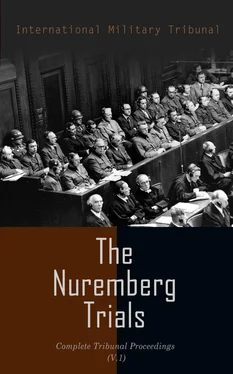Beginning with June 1943, the Germans carried out measures to hide the evidence of their crimes. They exhumed and burned corpses, and they crushed the bones with machines and used them for fertilizer.
At the beginning of 1944 in the Ozarichi region of the Bielorussian S.S.R., before liberation by the Red Army, the Germans established three concentration camps without shelters, to which they committed tens of thousands of persons from the neighboring territories. They brought many people to these camps from typhus hospitals intentionally, for the purpose of infecting the other persons interned and for spreading the disease in territories from which the Germans were being driven by the Red Army. In these camps there were many murders and crimes.
In the Estonian S.S.R. they shot tens of thousands of persons and in one day alone, 19 September 1944, in Camp Kloga, the Germans shot 2,000 peaceful citizens. They burned the bodies on bonfires.
In the Lithuanian S.S.R. there were mass killings of Soviet citizens, namely: in Panerai at least 100,000; in Kaunas more than 70,000; in Alitus about 60,000; at Prenai more than 3,000; in Villiampol about 8,000; in Mariampol about 7,000; in Trakai and neighboring towns 37,640.
In the Latvian S.S.R. 577,000 persons were murdered.
As a result of the whole system of internal order maintained in all camps, the interned persons were doomed to die.
In a secret instruction entitled “the internal regime in concentration camps”, signed personally by Himmler in 1941 severe measures of punishment were set forth for the internees. Masses of prisoners of war were shot, or died from the cold and torture.
(b) Murders and ill-treatments at places in the Eastern Countries and in the Soviet Union, other than in the camps referred to in (a) above, included, on various dates during the occupation by the German Armed Forces:
The destruction in the Smolensk region of over 135,000 Soviet citizens.
Among these, near the village of Kholmetz of the Sychev region, when the military authorities were required to remove the mines from an area, on the order of the Commander of the 101st German Infantry Division, Major-General Fisler, the German soldiers gathered the inhabitants of the village of Kholmetz and forced them to remove mines from the road. All of these people lost their lives as a result of exploding mines.
In the Leningrad region there were shot and tortured over 172,000 persons, including over 20,000 persons who were killed in the city of Leningrad by the barbarous artillery barrage and the bombings.
In the Stavropol region in an anti-tank trench close to the station of Mineralny Vody, and in other cities, tens of thousands of persons were exterminated.
In Pyatigorsk many were subjected to torture and criminal treatment, including suspension from the ceiling and other methods. Many of the victims of these tortures were then shot.
In Krasnodar some 6,700 civilians were murdered by poison gas in gas vans, or were tortured and shot.
In the Stalingrad region more than 40,000 persons were tortured and killed. After the Germans were expelled from Stalingrad, more than a thousand mutilated bodies of local inhabitants were found with marks of torture. One hundred and thirty-nine women had their arms painfully bent backward and held by wires. From some their breasts had been cut off and their ears, fingers, and toes had been amputated. The bodies bore the marks of burns. On the bodies of the men the five pointed star was burned with an iron or cut with a knife. Some were disembowelled.
In Orel over 5,000 persons were murdered.
In Novgorod and in the Novgorod region many thousands of Soviet citizens were killed by shooting, starvation, and torture. In Minsk tens of thousands of citizens were similarly killed.
In the Crimea peaceful citizens were gathered on barges, taken out to sea and drowned, over 144,000 persons being exterminated in this manner.
In the Soviet Ukraine there were monstrous criminal acts of the Nazi conspirators. In Babi Yar, near Kiev, they shot over 100,000 men, women, children, and old people. In this city in January 1942, after the explosion in German Headquarters on Dzerzhinsky Street the Germans arrested as hostages 1,250 persons—old men, minors, women with nursing infants. In Kiev they killed over 195,000 persons.
In Rovno and the Rovno region they killed and tortured over 100,000 peaceful citizens.
In Dnepropetrovsk, near the Transport Institute, they shot or threw alive into a great ravine 11,000 women, old men, and children.
In Kamenetz-Podolsk Region 31,000 Jews were shot and exterminated, including 13,000 persons brought there from Hungary.
In the Odessa Region at least 200,000 Soviet citizens were killed.
In Kharkov about 195,000 persons were either tortured to death, shot, or gassed in gas vans.
In Gomel the Germans rounded up the population in prison, and tortured and tormented them, and then took them to the center of the city and shot them in public.
In the city of Lyda in the Grodnen region on 8 May 1942, 5,670 persons were completely undressed, driven into pens in groups of 100, and then shot by machine guns. Many were thrown in the graves while they were still alive.
Along with adults the Nazi conspirators mercilessly destroyed even children. They killed them with their parents, in groups, and alone. They killed them in children’s homes and hospitals, burying the living in the graves, throwing them into flames, stabbing them with bayonets, poisoning them, conducting experiments upon them, extracting their blood for the use of the German Army, throwing them into prison and Gestapo torture chambers and concentration camps, where the children died from hunger, torture, and epidemic diseases.
From 6 September to 24 November 1942, in the region of Brest, Pinsk, Kobren, Dyvina, Malority, and Berezy-Kartuzsky about 400 children were shot by German punitive units.
In the Yanov camp in the city of Lwow the Germans killed 8,000 children in two months.
In the resort of Tiberda the Germans annihilated 500 children suffering from tuberculosis of the bone, who were in the sanatorium for the cure.
On the territory of the Latvian S.S.R. the German usurpers killed thousands of children, whom they had brought there with their parents from the Bielorussian S.S.R., and from the Kalinin, Kaluga, and other regions of the R.S.F.S.R.
In Czechoslovakia as a result of torture, beating, hanging, and shootings, there were annihilated in Gestapo prisons in Brno, Seim, and other places over 20,000 persons. Moreover, many thousands of internees were subjected to criminal treatment, beatings, and torture.
Both before the war, as well as during the war, thousands of Czech patriots, in particular Catholics and Protestants, lawyers, doctors, teachers, etc., were arrested as hostages and imprisoned. A large number of these hostages were killed by the Germans.
In Greece in October 1941, the male populations between 16 and 60 years of age of the Greek villages Amelofito, Kliston, Kizonia Mesovunos, Selli, Ano-Kerzilion and Kato-Kerzilion were shot—in all 416 persons.
In Yugoslavia many thousands of civilians were murdered. Other examples are given under paragraph (D), “Killing of Hostages”, below.
(B) DEPORTATION FOR SLAVE LABOR AND FOR OTHER
PURPOSES OF THE CIVILIAN POPULATIONS OF AND IN
OCCUPIED TERRITORIES
During the whole period of the occupation by Germany of both the Western and the Eastern Countries it was the policy of the German Government and of the German High Command to deport able-bodied citizens from such occupied countries to Germany and to other occupied countries for the purpose of slave labor upon defense works, in factories, and in other tasks connected with the German war effort.
Читать дальше












